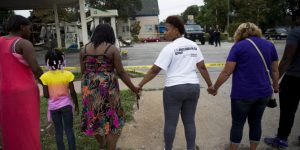(Akiit.com) My city, my hometown, is burning. This weekend, Milwaukee saw a riot on Sherman Blvd. Police and race relations in Milwaukee are fragile. The public is outraged and placing blame. With fingers pointed, the outcome is still the same. Families in Milwaukee who’ve felt victimized by the police haven’t gained resolution. In communities where there is no justice, the outcome is often no peace. People revolt when they feel they’ve run out of options, when people feel like they have nothing to lose they don’t mind destroying what others have.
Instead of being outraged with the city, we should take a closer look at the root causes of violence and work together to improve the quality of life in our neighborhoods. We should be building towards the same goal, that all of our community members are afforded the same opportunities and success as any other person in any zip code across the city.
Poverty, systemic racism and oppression contribute significantly to community violence. When we address the poor outcomes for people in neighborhoods plagued with poverty, we can prevent a significant amount of violence and create pathways towards prosperity.
Instead of being outraged with the city, we should take a closer look at the root causes of violence and work together to improve the quality of life in our neighborhoods.
Housing security impacts community violence. By examining the data on foreclosure we know that home ownership around Sherman Park plays a part in the events this past weekend. The national foreclosure rate is down 4.9 percent. Foreclosure in Wisconsin is down 22.7 percent. Although there is a decline in foreclosure, Milwaukee Black households had the lowest homeownership rate at 32 percent.
down 22.7 percent. Although there is a decline in foreclosure, Milwaukee Black households had the lowest homeownership rate at 32 percent.
Communities of color are negatively impacted by the foreclosure crisis. This contributes to the rising racial wealth gap. Historically, Sherman Blvd. was a destination for black home ownership. Today Sherman Blvd. is in the zip code with the highest foreclosure rate; 53216. Sixty-seven percent of the homes in 53,216 are bank-owned. Today Sherman Blvd. is struggling to recover.
Employment and educational opportunities available in Milwaukee impact community violence. Twenty-six percent of Milwaukee residents are living in poverty, and 38 percent are Black. Seventeen percent of 16 to 24 year olds are not working or in school, 24 percent are Black. Sherman Blvd. and the surrounding area have a high percentage of black youth that are unemployed. During summer vacation this leaves young people with nothing to do. When I was a teen there were so many opportunities to engage in healthy social activities.
Today, the funding for quality youth programs and jobs is slim. Our teens spent most of their summer with idle time. The intersection where the riot occurred has been an area of concern the entire summer. Countless youth workers and activist groups have organized activities for the teens to prevent potential violence. And although those efforts contributed positively to the area, the lack of resources to continue the engagement finally took its toll.
It’s easy to place blame, accuse parents of not doing their job, blame elected officials for the conditions we are in, and avoid neighborhoods where this is happening. However, there are several more contributing factors that led to the riot this past weekend. Multiple barriers to success stand in the way of young people in my city, and when you complicate those factors with an overall lack of dignity and respect you get self-destructive behavior.
Many people believe that they’ve run out of options. The most dangerous person in a community is the one that has nothing to lose. Yet, the most dangerous action or inaction is not doing anything to change the current conditions. Stepping up to do something to change the world we see today takes hard work and courage.
Many people believe that they’ve run out of options. The most dangerous person in a community is the one that has nothing to lose.
We are committed to restoring this city to a thriving global center and staying in the fight for justice. Yes, the cards are stacked against us, but we fight to change the community conditions that contribute to moments like this. We are breaking the cycle of poverty and scarcity mindset. Although the conditions have been bad, we are seeing a community transition. Although the media is showing us in the worst light there are many people that have been at ground zero of this situation for months. The conditions on Sherman Blvd. today are temporary. People in Milwaukee are change agents — we got this.
As we work to sustain economically diverse and abundant communities at Walnut Way Conservation Corporation, we will serve as a participant in resolving community violence. Over the last few months our staff have launched the Peace Project, and are working to build a culture of restorative justice, community mediation and peacekeeping in our neighborhoods. Now more than ever we resolve to pull together and embrace our young people in an effort to identify their talents and activate their assets.
Albert Einstein said, “A large part of history is replete with the struggle for human rights, an eternal struggle in which a final victory can never be won. But to tire in that struggle would mean the ruin of society.”
We commit to stay in the struggle for human rights no matter how tense the environment becomes. We look forward to working collaboratively with community members, stakeholders and partners in peace to nurture civic engagement, environmental stewardship, and creating venues for prosperity.
We invite you too to make the personal commitment to invest in the long haul struggle, create change, eliminate systems of oppression, and invest in new systems of elevation. This is our city.
Columnist; LaShawndra Vernon
Official website; http://www.walnutway.org









Leave a Reply